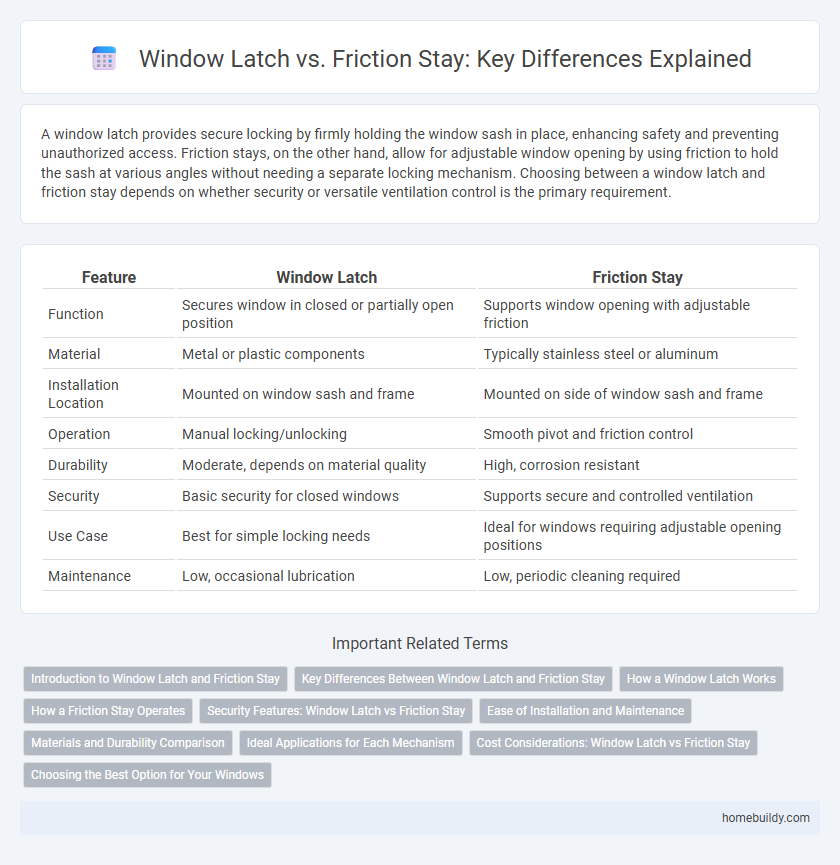A window latch provides secure locking by firmly holding the window sash in place, enhancing safety and preventing unauthorized access. Friction stays, on the other hand, allow for adjustable window opening by using friction to hold the sash at various angles without needing a separate locking mechanism. Choosing between a window latch and friction stay depends on whether security or versatile ventilation control is the primary requirement.
Table of Comparison
| Feature | Window Latch | Friction Stay |
|---|---|---|
| Function | Secures window in closed or partially open position | Supports window opening with adjustable friction |
| Material | Metal or plastic components | Typically stainless steel or aluminum |
| Installation Location | Mounted on window sash and frame | Mounted on side of window sash and frame |
| Operation | Manual locking/unlocking | Smooth pivot and friction control |
| Durability | Moderate, depends on material quality | High, corrosion resistant |
| Security | Basic security for closed windows | Supports secure and controlled ventilation |
| Use Case | Best for simple locking needs | Ideal for windows requiring adjustable opening positions |
| Maintenance | Low, occasional lubrication | Low, periodic cleaning required |
Introduction to Window Latch and Friction Stay
Window latches secure windows in closed positions, enhancing safety and preventing drafts, while friction stays control window movement by providing adjustable friction to keep windows open at varying angles. Unlike friction stays, which are hinged metal arms allowing smooth, controlled opening and closing, window latches function primarily as locking devices ensuring the window remains firmly shut. Both components contribute to window functionality, with latches focusing on security and friction stays on controlled ventilation and stability.
Key Differences Between Window Latch and Friction Stay
Window latches primarily function as locking mechanisms that secure windows in a fixed position, while friction stays are designed to support and control the opening angle by applying adjustable resistance. The key difference lies in functionality: window latches provide security by fastening the sash, whereas friction stays enable smooth ventilation control without compromising stability. Materials for window latches typically include metal or durable plastic, whereas friction stays are usually constructed from stainless steel for strength and corrosion resistance.
How a Window Latch Works
A window latch secures the window by engaging a catch or strike plate, creating a tight seal that prevents the window from opening unintentionally. Unlike a friction stay, which relies on adjustable friction to hold the window in place, a latch physically locks the sash into the frame for enhanced security. The mechanism typically involves a rotating or sliding component that aligns with the corresponding hardware to maintain closure and resist external forces.
How a Friction Stay Operates
A friction stay operates by using a hinge mechanism combined with friction-controlled arms to hold a window at various open positions without additional support. Unlike a window latch, which primarily secures the window closed, a friction stay allows smooth operation and stable positioning during ventilation. Its design ensures controlled movement and resistance, preventing the window from slamming shut or swinging open abruptly.
Security Features: Window Latch vs Friction Stay
Window latches provide enhanced security by securely locking the window, preventing unauthorized opening and offering resistance against forced entry. Friction stays primarily control the window's opening angle for ventilation, lacking robust locking mechanisms and therefore offering limited security. Choosing window latches over friction stays significantly improves protection against break-ins, making them essential for secure window installations.
Ease of Installation and Maintenance
Window latches offer a straightforward installation process with minimal hardware requirements, making them easier to fit compared to friction stays that often need precise alignment and multiple screws. Maintenance of window latches is simpler due to fewer moving parts, reducing the risk of wear and tear, whereas friction stays require regular lubrication and adjustment to ensure smooth operation. The durability and ease of replacement of window latches contribute to lower long-term maintenance costs relative to the more complex friction stay mechanisms.
Materials and Durability Comparison
Window latches are commonly crafted from high-grade metals such as stainless steel and zinc alloy, offering superior corrosion resistance and longevity compared to friction stays typically made from mild steel or aluminum, which may be prone to wear and bending over time. The robust construction of window latches ensures enhanced durability under frequent use and exposure to environmental factors, while friction stays often require regular maintenance to maintain optimal performance. Choosing a window latch with durable materials significantly extends the lifespan and reliability of window hardware in residential and commercial applications.
Ideal Applications for Each Mechanism
Window latches provide secure locking and are ideal for applications requiring robust security and ease of operation, such as residential windows and small ventilation openings. Friction stays offer adjustable window positioning and are best suited for casement and awning windows where controlled airflow and partial opening are needed. Choosing between the two depends on the required balance between security and ventilation control in the specific window design.
Cost Considerations: Window Latch vs Friction Stay
Window latches generally offer a lower upfront cost compared to friction stays, making them a budget-friendly option for securing windows. Friction stays, while more expensive, provide enhanced durability and adjustable positioning, potentially reducing long-term maintenance expenses. Considering installation and replacement expenses, window latches require simpler installation, whereas friction stays might incur higher labor costs due to complexity.
Choosing the Best Option for Your Windows
Window latches provide secure locking mechanisms that enhance safety and prevent unauthorized access, while friction stays offer adjustable support for window positioning and smooth operation. Choosing the best option depends on the primary need: if security is a priority, window latches are ideal; for controlled ventilation and ease of movement, friction stays are preferable. Combining both hardware types often results in optimal functionality, balancing security and flexible window use.
window latch vs friction stay Infographic

 homebuildy.com
homebuildy.com